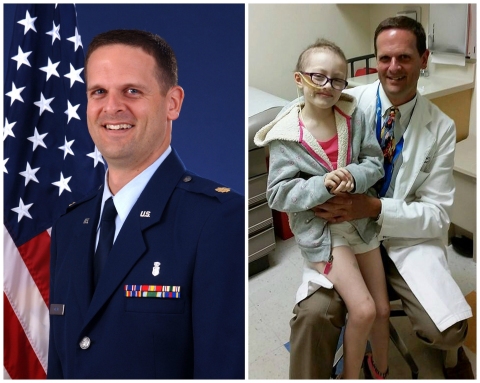STANFORD, Calif.--(BUSINESS WIRE)--“One of the most important things to have in an operating room is a captain, who is calm under pressure,” said Gerald Grant, MD, chief of pediatric neurosurgery at Stanford Children’s Health and a former lieutenant colonel in the U.S. Air Force. “When you’ve been to war, you understand how to have a commanding presence, how to make quick decisions and how to keep your cool.”
On Veterans Day 2014, Grant is reflecting on his service to our country and how it impacts his lifesaving care for kids. In 2005, at the height of the Iraq war, Grant was one of 18 U.S. Air Force and Army surgeons in a tent hospital at Balad Air base, the largest U.S. military base in Iraq. Located outside Balad in the Sunni Triangle, the base housed the Air Force Theater Hospital, a level 1 trauma center.
They came pouring in. Wounded soldiers, Special Forces fighters, civilians who were in the wrong place at the wrong time – even terrorists under guard – many with injuries doctors had never seen before.
Grant, then a 39-year-old Air Force major who had recently finished residency at the University of Washington, was the Theater Hospital’s Chief of Neurosurgery. Under the Health Professions Scholarship Program, the Air Force had paid for him to attend the Stanford University School of Medicine to become a physician. In return, Grant proudly served his country on active duty from 2002 to 2006.
But his crucible was six months in Iraq.
With minimal staff and so many patients, he did a little of everything. The experience of operating under fire – insurgents constantly hurling rockets at the base and dealing with improvised explosive device-inflicted wounds that doctors were shocked hadn’t been mortal – upped his game like no other training could.
Grant, also an associate professor of neurosurgery at the Stanford University School of Medicine, said there is nothing like the experience of war to forever quicken a surgeon’s reaction time or heighten his or her instincts in the operating room.
“We were dealing with injuries we’d never seen or dealt with before,” Grant said. “We were not used to the damage done by some of these homemade devices, including roadside bombs that a terrorist would detonate with a cell phone. We were seeing people with pieces of the road embedded in their brains – and they were surviving. But we still had to develop treatments for them.”
And, in the middle of a surgery, it wasn’t uncommon for air-raid sirens to go off.
“They were called ‘red alerts’ and everyone was supposed to go into the bunker for safety,” Grant said. “A lot of the rockets would land near the hospital – many of which never exploded or were deactivated by a special bomb crew. Nevertheless, we couldn’t take shelter, not while someone was on the table.”
That made the doctors and nurses especially vulnerable to attack, but it was all part of the job, Grant said. Even treating dangerous terrorists was included in a day’s work.
“We were so busy we didn’t have time to think about it,” he said. “Our job was to be as fast and efficient as possible.” After emergency treatment, the American soldiers were almost always transported to Landstuhl Regional Medical Center in Germany for long-term care.
Grant, a husband and father of three – 10 and 14-year-old sons and a 12-year-old daughter – said there are many parallels between the children he now sees and his former soldier patients.
“They’re both just so resilient,” he said. “They want to get back to whatever they were doing, whether it’s fighting a war or going back to the playground.”
As for Grant, the skills he earned in Iraq also made him a more resilient neurosurgeon for the cases he sees at Lucile Packard Children’s Hospital Stanford. He no longer operates under missile attacks, but triaging war-trauma patients made him fast at detecting critical warning signs, including when a child’s blood isn’t properly clotting and how to jump in with early intervention.
“I feel I can sense problems promptly because I have so much experience with emergencies in austere conditions,” said Grant, who is proud to be a veteran. “My time in Iraq is definitely a part of who I am, and I think it has played a large role in helping me care for kids.”
About Stanford Children’s Health and Lucile Packard Children’s Hospital Stanford
Stanford Children’s Health, with Lucile Packard Children’s Hospital Stanford at its core, is an internationally recognized leader in world-class, nurturing care and extraordinary outcomes in every pediatric and obstetric specialty from the routine to rare, for every child and pregnant woman. Together with our Stanford Medicine physicians, nurses, and staff, we deliver this innovative care and research through partnerships, collaborations, outreach, specialty clinics and primary care practices at more than 200 locations in the U.S. western region. As a non-profit, we are committed to supporting our community – from caring for uninsured or underinsured kids, homeless teens and pregnant moms, to helping re-establish school nurse positions in local schools. Learn more about our full range of preeminent programs and network of care at stanfordchildrens.org, and on our Healthier, Happy Lives blog. Join us on Facebook, Twitter, LinkedIn and YouTube.
Lucile Packard Children’s Hospital Stanford is the heart of Stanford Children’s Health, and is one of the nation’s top hospitals for the care of children and expectant mothers. For a decade, we have received the highest specialty rankings of any Northern California children’s hospital, according to U.S. News & World Report’s 2014-15 Best Children’s Hospitals survey, and are the only hospital in Northern California to receive the national 2013 Leapfrog Group Top Children’s Hospital award for quality and patient care safety. Discover more at stanfordchildrens.org.




